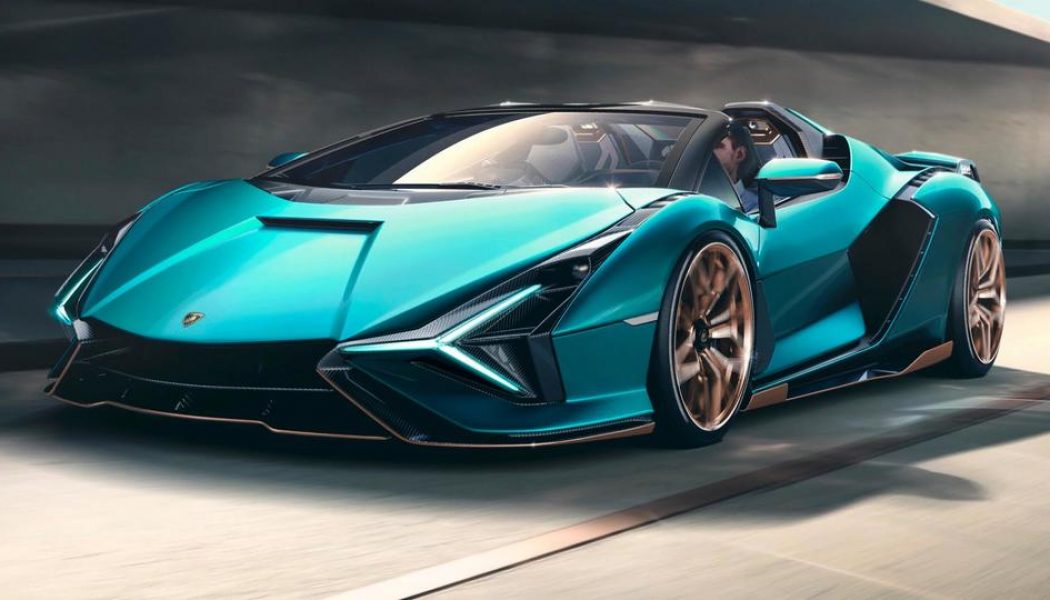The Lamborghini Sián Roadster, like its hardtop predecessor, is the sort of Lamborghini that the company describes as coming out of its “laboratory of the future”—experimenting with electrification techniques to figure out how to move the company into its next era of performance. We know some of the broad strokes of this plan, especially that the next Aventador will be a hybrid. But Lamborghini continues to drop hints about the specifics of its plans.
Why electrification at all? For one, emissions and noise regulations are forcing the change. That’s nothing new and shouldn’t come as a surprise. It’s clear that Lamborghini probably would not electrify its cars if regulations didn’t require it. But the company is making the most of the situation, working closely with MIT to optimize the relevant technologies, and as the Sián shows, making sure that electrification actually enhances the vehicle itself, as opposed to merely allowing it to comply with regulations. But battery-electric vehicles are a long way off for the company, as the technology is simply not able to meet the company’s real-world performance targets without massive leaps in energy storage tech. In short, it’s something to muse on, as with the Terzo Millennio, but not build anytime soon.
As Giovanni Perosino, Lamborghini’s chief commercial officer, told us in a recent roundtable interview, the transition to electrically-enhanced gasoline engines might be less monumental to Lamborghini’s customers than it is to us, the wonks who hang on every detail. According to Perosino, the most important thing is to “have a clear brand purpose” and to communicate that Lamborghini has a forward-looking vision, while also dabbling in new and exciting technologies. As long as Lamborghini surfs on that wave of innovation and exhilaration, the specifics—such as the sounds a Lamborghini makes—are less important.
Don’t take that to mean that everything’s on the table. Maurizio Reggiani, the brand’s chief technical officer, made it clear in the past—and re-emphasized in our discussion—that the V-12 is a central pillar to Lamborghini’s mystique. Asked whether the V-12 had a future, Reggiani was clear that cylinder count is important to the brand’s customers. On the subject of displacement, Reggiani dodged a bit. Reading between the lines, we can assume that Lamborghini would rather downsize the V-12 than drop its top-of-the-line performance cars’ cylinder counts (if one or the other is required).
What about the Sián’s fascinating supercapacitor tech? It allows for “symmetrical” charging and discharging functionality. In other words, you can dump energy into it and extract it at roughly the same rate, something no conventional hybrid battery does. It appeals to Reggiani, too, because being small and light, the tech is easy to package within the car as well. It’s clear from our conversation the supercapacitor isn’t a one-off item earmarked strictly for the Sián. That said, Reggiani made it known that we won’t see it find a home in the brand’s forthcoming Aventador replacement.
Instead, the upcoming model will utilize conventional battery technology. It’s a conservative move because unlike the Sián, Aventador owners tend to use their cars frequently, putting significant (for a hypercar) mileage on the mid-engined machines each year. By going the more conservative route of a conventional battery pack, Lamborghini’s top-of-the-line mass-produced (well, in hypercar terms) model will offer broader electric operation. In layman’s terms, a traditional battery pack does a better job of helping the company meet regulatory requirements than a low-capacity supercapacitor can.
After all, the Sián’s supercapacitor can only store 0.18 kWh of electricity. That’s enough juice to moderate the car’s single-clutch automated transmission’s, uh, brutal shift characteristics and enhance acceleration, but not enough to provide the model with any significant EV-only operation. But the next Aventador will adopt a dual-clutch gearbox, mitigating the need to use all that energy to smooth out shifts.
Thinking about the next Aventador is thrilling, but the Urus is a truly important vehicle for Lamborghini in the here and now. It seems we’ve heard about the potential for a plug-in hybrid version of the company’s crossover SUV for ages now, and Reggiani acknowledged the company is still “examining” it. It seems the Italian brand wants to make sure the system actually enhances the driving experience of the Urus—simply reducing emissions and providing some EV-only range isn’t enough.
Additionally, a sibling for the Urus is not in the cards. This news meshes with previous statements by the brand, with Perosino underlining that he’s against such a move. If anything, the company would love to add another performance car to its model line. We’ve heard statements like this before, and we view this as a generalized wish by the CCO rather than confirmation that another Lamborghini model line is in the works.
One thing is clear, though: Lamborghini’s future is electrified. How Sant’Agata will carry out this transformation remains a bit of a mystery. Nevertheless, we’re slowly filling in the blanks.










